| ENTS,
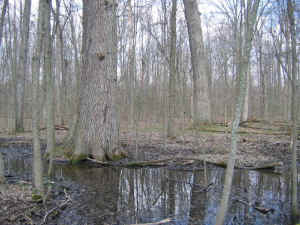
Bur oak in Swamp Relict
Tom Diggins and I met at the parking lot for Goll Woods State
Nature
Preserve last Tuesday, April 10th, 2007. The weather was great
and the water
level low in this relic of the immense Black Swamp that covered
much of NW
Ohio. This tiny remnant is virtually all that is left of a huge
swamp forest
that was drained for farmland.
http://www.dnr.state.oh.us/dnap/location/goll_woods.html
Better yet, the clouds of mosquitoes that Bob Leverett fed last
summer were
nowhere to be found. Tom and I, stoked on leftover Easter
chocolate, began
our walk on the Bur Oak Trail. Numerous impressive trees were
instantly
spotted and our path turned into a random zig-zag from tree to
tree. In a
matter of minutes we actually ended up on the Tuliptree Trail
across the
road from the Bur Oak Trail. Strongly led further in that
direction we
continued measuring the huge bur oaks. Numerous forest grown
specimens with
long, massive trunks dominated the scene. On slightly lower and
wetter sites
cottonwood, ash, sycamore, elms and hackberry took over;
however, bur oaks
grew right into the wettest areas. Sugar maples and shaggy
hickories, both
shagbark and shellbark, were scattered throughout along with a
few
tuliptrees, black cherry, pignut, bitternut and American
basswood. I was
shocked that valuable trees were not poached adjacent to the
roads. Some of
the white oaks, ash and black cherry were of excellent quality
and very easy
to access.
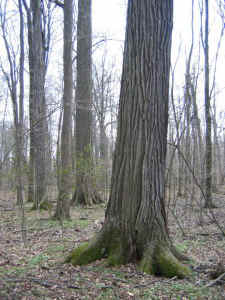
Bur Oak and Shagbark |
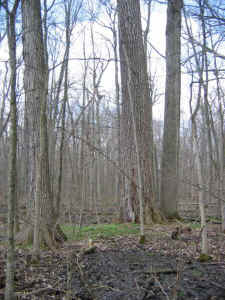
Giant Cottonwood and Bur Oak |
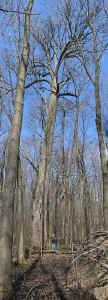
Goll Woods Bur Oak |
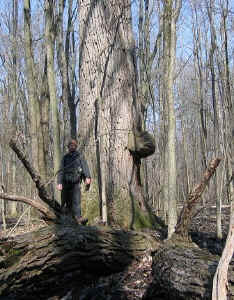
Will and huge Bur Oak |
For me, several species occurred there that were new to me in
their native
habitat. Rock elm grew in the mid-story and several specimens
had really
cool, twisted and heavily winged twigs (the state record grows
here).
Shellbark was a new one for me and only by finding the scattered
nuts in the
muck could I attempt to separate them from shagbark. Blue ash
also occurred
in the wet sections and had smooth bark like no other ash. Ohio
buckeye was
also a welcome new species as they were in early leaf and added
some green
to the otherwise muddy-gray forest. Black ash, black maple and
blackgum were
supposed to occur there but I did not see what I would call a
black ash nor
did I spot a single blackgum. Tom and I speculated on black
maple but good
leaves were not obtainable. The understory was diverse, with
spicebush the
most common shrub. Bladdernut was sporadic, as was paw-paw and
elderberry.
Understory trees were mostly Ohio buckeye, ironwood and a few
hophornbeam. A
very nice hawthorn or perhaps crabapple grew along side the
Tuliptree trail.
We could not figure it out due to no fruits or flowers present,
and
unfortunately I also forgot to measure it on the way back.
Tom and I were partly distracted by an ancient green ash that
had just
fallen across the trail. Trail crews had cut it and a rough ring
count went
over 300 years. We pounded and cracked off sections to send to
Neil. Later,
I counted a bur oak log that had been cut to clear a trail and
it too went
over 300 years.
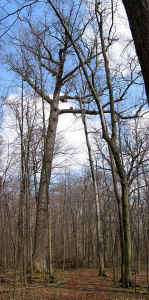
Goll Woods White Oak |
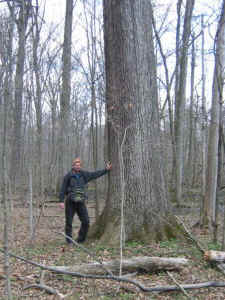
Huge White Oak |
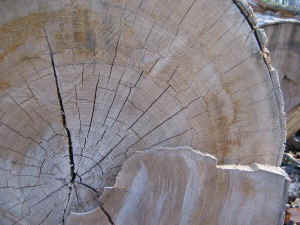
Old Green Ash |
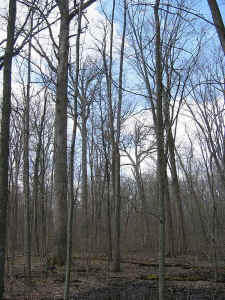
Towering Bur Oak |
In all, the site was very diverse, with at least seven species
of oaks, four
species of ash, four species of hickory, and two species of elm.
Keeping
them all straight took some effort! Cottonwood dominated the
tall tree realm
while bur oak strongly dominated the big tree scene. 40"
diameter bur oaks
were common with 50 inch trees commonly encountered. Cottonwood
was the only
species to break 130' in height, but tuliptree and bur oak were
not far
behind- both over 128'. Tom's laser shot on a white ash put it
over 130' but
I was not able to confirm it from several locations. For now I
have my
lasered height listed below. Here are the Rucker height and
girth indices:
|
Rucker
10 Height
|
|
Cottonwood
|
131.1
|
|
Tuliptree
|
129.1
|
|
Bur
oak
|
128.6
|
|
Sycamore
|
127.5
|
|
White
ash
|
127.0
|
|
Swamp
white oak
|
119.2
|
|
Shagbark
|
118.3
|
|
Shellbark
|
117.6
|
|
N.
red oak
|
116.3
|
|
Shumard
oak
|
116
|
|
RHI
10=
|
123.07
|
|
Rucker
10 Girth
|
CBH
|
|
Bur
oak
|
16.59
|
|
Cottonwood
|
15.36
|
|
Shumard
oak
|
14.76
|
|
Tuliptree
|
14.52
|
|
White
oak
|
13.71
|
|
Swamp
white oak
|
13.35
|
|
N.
red oak
|
12.17
|
|
White
ash
|
11.28
|
|
Red
maple
|
10.96
|
|
Chinquapin
oak
|
10.65
|
|
RGI
10=
|
13.34
|
Other notable trees measured were:
|
Red
maple
|
41.9"
|
112.9'
|
|
Bitternut
|
31"
|
112.7'
|
|
Amer.
basswood
|
28.2"
|
112.2'
|
|
Amer.
beech
|
32.2"
|
111.1'
|
|
Bigtooth
aspen
|
19.9"
|
108.6'
|
|
White
oak
|
52.4"
|
108.0'
|
|
Chinquapin
oak
|
40.7"
|
99.9'
|
|
Amer.
elm
|
25.2"
|
99.1'
|
|
Boxelder
|
15.7"
|
80.4'
|
Will Blozan
President, Eastern Native Tree Society
President, Appalachian Arborists, Inc.
|